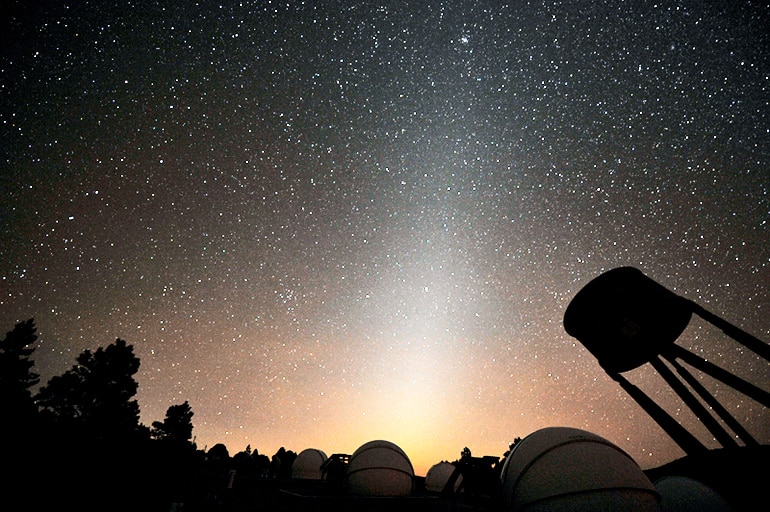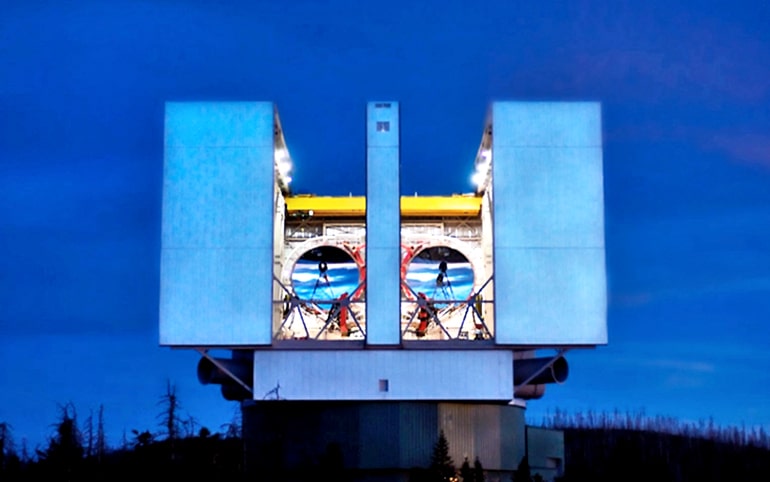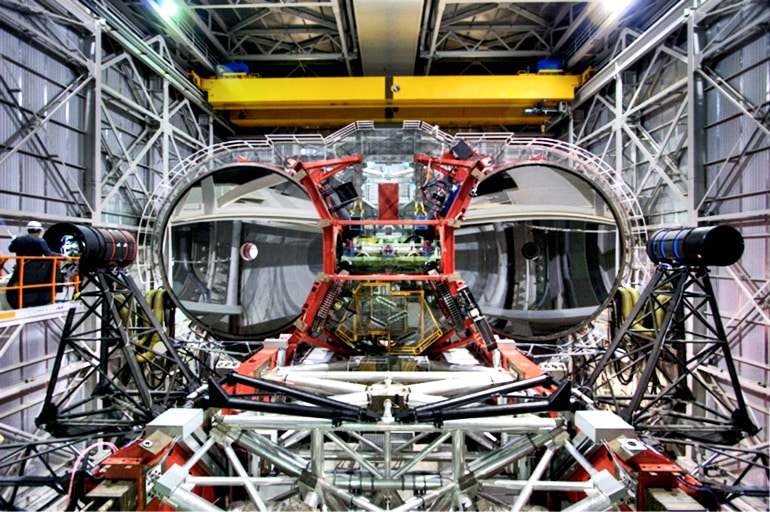New research sheds light on which stars might be harboring exoplanets that would make the best candidates for future exploration, as well as how large the telescopes that astronomers would use to study them need to be.
Imagine trying to see a firefly next to a distant spotlight, where the beams from the spotlight all but drown out the faint glow from the firefly. Add fog, and dim both lights. Is the glow from the firefly still visible at all?
That’s the question researchers asked themselves as part of the Hunt for Observable Signatures of Terrestrial Systems, or HOSTS, Survey, but on a cosmic scale.
Using the Large Binocular Telescope Interferometer, or LBTI, in Arizona, the HOSTS Survey determines the brightness and density of warm dust floating in nearby stars’ habitable zones, where liquid water could exist on the surface of a planet.

This research will contribute to a once-per-decade report on the field of astrophysics that the National Academies produces. NASA uses the report to help chart a course for future missions, some of which could continue the search for planets around other stars, known as exoplanets.
Before scientists can design telescopes for prospective exoplanet-hunting missions, astronomers must know if there is a fundamental limit to their ability to see a tiny, dim planet next to a bright star when the system is shrouded in dust.
“Our result is that there is no fundamental problem,” says Steve Ertel of the University of Arizona’s Steward Observatory, instrument scientist for the Large Binocular Telescope Interferometer and lead author on the paper, which appears in the in the Astronomical Journal. “Now it is a technical challenge.”

A potential mission to search for terrestrial planets probably would include a space-based telescope, and the HOSTS Survey will help determine its size.
‘Zodiacal dust’
“The more dust there is, the bigger the telescope has to be to image a planet,” Ertel says. “It is important to know what telescope size is required, so the costs can be minimized.”
The dust that orbits in the plane of our solar system is known as “zodiacal dust.” The HOSTS Survey determined that the typical level of zodiacal dust around other stars—called “exo-zodiacal dust”—is less than 15 times the amount found in our own solar system’s habitable zone.
Stars with more than that amount of dust make poor targets for future exoplanet imaging missions, as planets would be difficult to see through the haze. One such star with a prominent dust disk, called Epsilon Eridani, is one of the 10 nearest stars investigated by the HOSTS Survey.
“It is very nearby,” Ertel says. “It’s a star very similar to our sun. It would be a very nice target to look at, but we figured out that it would not be a good idea. You would not be able to see an Earth-like planet around it.”
If dust and debris make finding rocky worlds challenging, then why search for planets in dusty systems?
“There is dust in our own solar system,” says Philip Hinz, the lead for the HOSTS Survey team and associate professor of astronomy. “We want to characterize stars that are similar to our own solar system, because that’s our best guess as to what other planetary systems might have life.”
The pattern of dust distribution around a host star also can tell astronomers something about the potential planets in a star system. Some stars have wide, continuous disks that fill the whole system. This is considered a standard model, as dust is formed during asteroid collisions far from the star and then spirals inward toward the star so that it is evenly distributed throughout the system.
“This is something that we expected to see, but we also saw some surprises,” Ertel says.

Take Vega, one of the brightest stars in the night sky. For more than 30 years, astronomers have known that Vega has a massive belt of cold dust far from the star, analogous to our solar system’s Kuiper Belt. The star also has a disk of hot dust very close to it.
“We were thinking that Vega must have dust in the habitable zone as well, because it has dust very close and dust farther away,” Ertel says. “But we looked at Vega’s habitable zone and we didn’t find anything.”
Vega’s habitable zone is devoid of detectable dust, which could indicate that the system has planets that prevent dust from collecting there. Planets have not yet been detected around Vega, but current observations are not even sensitive enough to detect a planet as large as Jupiter near the star, let alone Earth-like planets.
“This could be an indication of a planet we cannot see,” Ertel says. “It could be a massive planet outside the habitable zone, or it could be several Earth-mass planets.”
Other stars had different dust distributions: nothing far away or very close, but huge amounts of bright, warm dust in their habitable zones. If a star does not have a Kuiper Belt analogue producing dust, but it still has a ring of warm dust, there must be another mechanism at play in the system.
Simulating ‘haze’ may narrow search for alien life
“There might be giant planets like Jupiter and Saturn in that system, but that system’s asteroid belt has a lot of mass to it, so you’re getting a lot of collisions that make large amounts of dust,” Hinz says.
Studying these dust disks provides astronomers with more pieces to the puzzle of planetary architecture. While past studies have looked for planets very close to, and very far away from, stars to determine where planets are typically located in star systems, the HOSTS Survey is determining how dust and asteroid belts appear in the average star system.
“The survey is ongoing, so we have more questions than answers,” Hinz says. “We are in the early days for trying to figure out how it all fits together.”
Canceling out starlight
Exo-zodiacal dust has been warmed to room temperature by its host star, so it glows when viewed in infrared wavelengths—that is, in infrared light, emitted by heated objects. However, at those wavelengths, stars glow 10,000 times brighter than the dust.
To see how much dust was swirling around their chosen 30 stars, the HOSTS Survey detected the dust disks using a technique called “Bracewell nulling interferometry,” after Ronald Bracewell, the astronomer who first suggested the method.
“Interferometry means ‘measuring the interference between two wave trains,'” Hinz says.
The Large Binocular Telescope, or LBT, has the unique capability to perform this interferometry, as it is designed so that its twin telescopes can each detect light waves that are perfectly out of phase with each other. When waves are out of phase, they cancel each other out, causing their peaks and troughs to flatten.
“The result is that you cancel out the light from the star,” Hinz says.
A similar technique was introduced in 1998, using the Multiple Mirror Telescope on Arizona’s Mount Hopkins.
Telescopes capture blue glow of supernova collision
“It took almost 20 years to refine the technique so it is precise enough so that we could get rid of the star and sensitive enough so that we could see the remaining light from the dust,” Hinz says.
Achieving this cancellation requires that the LBT be adaptable. After light bounces off the telescope’s 8-meter primary mirrors, it reflects off the secondary mirrors and into detectors. The secondary mirrors are deformable so that they can correct for the distortions of light caused by ripples in the atmosphere.
In order for the interferometry to work, these corrections must be accurate to one one-hundredth of the width of a human hair.
The LBTI is 10 times more sensitive than the previous telescope capable of detecting exo-zodiacal dust, the Keck Interferometer Nuller, which completed its observations of exo-zodiacal dust in 2011. Learn more about the Keck Interferometer at NASA.
NASA’s Exoplanet Exploration Program office funds the LBTI, which the agency’s Jet Propulsion Laboratory in Pasadena, California manages. JPL is a division of Caltech.
The LBT is an international collaboration among institutions in the US, Italy, and Germany, and it is managed and headquartered at the University of Arizona.
Source: University of Arizona



